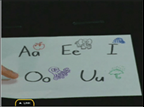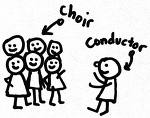 I have been through many exercises for unison vowel production, and the best I have found was taught to me by my own vocal coach, Dr.Jan E. Bickel, D.M.A at Saint Xavier University in Chicago. She gave it to me as an excellent way to practice a smooth phrase:
I have been through many exercises for unison vowel production, and the best I have found was taught to me by my own vocal coach, Dr.Jan E. Bickel, D.M.A at Saint Xavier University in Chicago. She gave it to me as an excellent way to practice a smooth phrase:
Take the phrase we used last time, “In the land of the living, I will walk with God all my days.”
- Take away the consonants, and now you are left with: “I e a o e i i, i i a i o a y a” (In the land of the living, I will walk with God all my days).
- Have the choir pronounce the vowel sounds as they appear in the phrase (no diphthongs): i uh a uh uh i ee, ah i aw i o aw ah A (In thuh land uhv thuh liveeng, Ah will wawk with God awll mah daze)
OK, get ready for mutiny….this takes a little time to master; visual handouts for the choir, or even the vowel sounds written on the board are essential; but what results!
- Now have the choir sing only the vowels on their correct pitches and then have them connect the vowels to each other, sing in a very legato manner to produce a smooth phrase.
- Finally, have them put the consonants back in (they’ll be soooo relieved), but lightly! Just touch the consonants.
This is a wonderful way to get your choir to produce a lovely, smooth, truly unison phrase. This same exercise is helpful for unlocking the breath.
….more later!
 Now that we’ve got the choir taking breaths simultaneously and completing phrases before taking the next breath, it’s time to move on to vowels.
Now that we’ve got the choir taking breaths simultaneously and completing phrases before taking the next breath, it’s time to move on to vowels. Ha! Take that, Twitter!
Ha! Take that, Twitter! I was under a director once, Robert Guenzler, when I was in high school. After spending a good portion of the first few sessions of the school year in practicing good unison singing, he always taught a piece to the choir in this way:
I was under a director once, Robert Guenzler, when I was in high school. After spending a good portion of the first few sessions of the school year in practicing good unison singing, he always taught a piece to the choir in this way: This morning I heard Fred Childs on NPR’s “Performance Today” speak about tempo. He used as an example Beethoven’s “Moonlight Sonata”; he contrasted two renditions: one was a very slow adagio, and the other quite a bit faster, more of an andante performance.
This morning I heard Fred Childs on NPR’s “Performance Today” speak about tempo. He used as an example Beethoven’s “Moonlight Sonata”; he contrasted two renditions: one was a very slow adagio, and the other quite a bit faster, more of an andante performance.
Comments